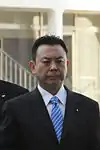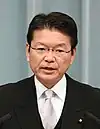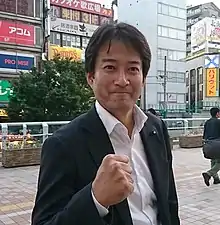| |||||||||||||||||||||||||||||||||||||||||||||||||||||||||||||||||||||||||||||||||||||||||||||||||||||||||||||||||||||||
All 127 seats in the Tokyo Metropolitan Assembly 64 seats needed for a majority | |||||||||||||||||||||||||||||||||||||||||||||||||||||||||||||||||||||||||||||||||||||||||||||||||||||||||||||||||||||||
|---|---|---|---|---|---|---|---|---|---|---|---|---|---|---|---|---|---|---|---|---|---|---|---|---|---|---|---|---|---|---|---|---|---|---|---|---|---|---|---|---|---|---|---|---|---|---|---|---|---|---|---|---|---|---|---|---|---|---|---|---|---|---|---|---|---|---|---|---|---|---|---|---|---|---|---|---|---|---|---|---|---|---|---|---|---|---|---|---|---|---|---|---|---|---|---|---|---|---|---|---|---|---|---|---|---|---|---|---|---|---|---|---|---|---|---|---|---|---|---|
| Turnout | 42.39% ( | ||||||||||||||||||||||||||||||||||||||||||||||||||||||||||||||||||||||||||||||||||||||||||||||||||||||||||||||||||||||
| |||||||||||||||||||||||||||||||||||||||||||||||||||||||||||||||||||||||||||||||||||||||||||||||||||||||||||||||||||||||
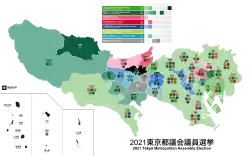 | |||||||||||||||||||||||||||||||||||||||||||||||||||||||||||||||||||||||||||||||||||||||||||||||||||||||||||||||||||||||
| |||||||||||||||||||||||||||||||||||||||||||||||||||||||||||||||||||||||||||||||||||||||||||||||||||||||||||||||||||||||
Prefectural elections for the Tokyo Metropolitan Assembly (令和3年/2021年東京都議会議員選挙, Reiwa 3-nen/2021-nen Tōkyō togikai giin senkyo, "Reiwa 3/2021 election of members of the Tokyo Metropolitan Assembly") were held on 4 July 2021. The 127 members were elected in forty-two electoral districts, seven returning single members elected by first-past-the-post, and thirty-five returning multiple members under single non-transferable vote.[2] Two districts had their magnitude adjusted in this election to match population changes.[3]
The results of the election saw the ruling Liberal Democratic Party (LDP) winning the most seats, displacing the regional party Tomin First no Kai to become the largest party in the Assembly. However the coalition of the LDP and their partner Komeito failed to win an outright majority of seats in what was widely described as a poor result for the LDP and Prime Minister Yoshihide Suga.[1][4]
Background
Yuriko Koike won the 2016 Tokyo gubernatorial election as an independent candidate, and left the LDP in June 2017 to found a new local political party, Tomin First, which won a majority in the 2017 Tokyo prefectural election along with its coalition partner, Komeito. Koike was then re-elected in the 2020 gubernatorial election.
Komeito had since announced that it would leave its coalition with Tomin First in the Metropolitan Assembly, instead seeking to enter into a governing coalition with the Liberal Democratic Party (both parties make up the ruling coalition in the National Diet). Koike was hospitalized on 22 June 2021 due to severe fatigue, however she was discharged on 30 June and made surprise appearances on 3 July, the final day of campaigning, to campaign in support of Tomin First candidates in various districts across central Tokyo.[5]
The election had been described as a potential bellwether for the upcoming general election.[6]
Electoral districts
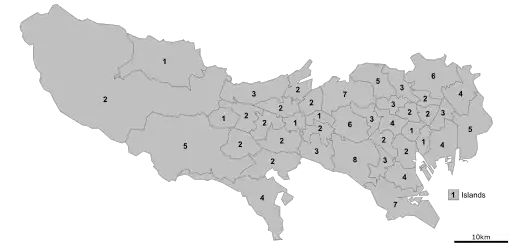
Most districts are coterminous with a municipality (-ku/-shi/-chō/-son) of the same name. The following districts comprise multiple municipalities:[7]
- Nishi-Tama ("West Tama“; follows the original boundaries of the district of the same name, except Ōme): Fussa, Hamura, Akiruno, Hinohara, Hinode, Mizuho, Okutama
- Minami-Tama ("South Tama“; follows the boundaries of the former district of the same name): Tama, Inagi
- Kita-Tama dai-1 ("North Tama #1“; follows the boundaries of the former Kitatama district): Higashi-Murayama, Higashi-Yamato, Musashi-Murayama
- Kita-Tama dai-2 ("North Tama #2“): Kokubunji, Kunitachi
- Kita-Tama dai-3 ("North Tama #3“): Chōfu, Komae
- Kita-Tama dai-4 ("North Tama #4“): Kiyose, Higashi-Kurume
- Islands: Aogashima, Hachijō, Mikurajima, Miyake, Ogasawara, Kōzushima, Niijima, Ōshima, Toshima
Candidates
| Party | Incumbents[8] | Candidates | |||||
|---|---|---|---|---|---|---|---|
| Incumbents | Previous
representatives |
New | (Women) | ||||
| Tomin First no Kai (Tomin)[9] | 46 | 42 | 0 | 5 | 47 | (18) | |
| Liberal Democratic Party (LDP)[10] | 25 | 22 | 15 | 23 | 60 | (9) | |
| Kōmeitō (Kōmei)[11] | 23 | 17 | 0 | 6 | 23 | (3) | |
| Japanese Communist Party (JCP)[12] | 18 | 16 | 1 | 14 | 31 | (18) | |
| Constitutional Democratic Party (CDP)[13] | 7 | 7 | 2 | 19 | 28 | (8) | |
| Tokyo Seikatsusha Network (Net)[14] | 1 | 0 | 1 | 2 | 3 | (3) | |
| Nippon Ishin no Kai (Ishin)[15] | 1 | 0 | 2 | 11 | 13 | (3) | |
| Democratic Party for the People (DPFP)[16] | 0 | 0 | 3 | 1 | 4 | (0) | |
| Reiwa Shinsengumi (Reiwa)[17] | 0 | 0 | 0 | 3 | 3 | (3) | |
| Other | 59 | ||||||
| Independent | |||||||
| Total | 126
(1 vacancy) |
271 | |||||
Results
The majority Liberal Democratic Party (LDP) won the most seats in the election, displacing the regional party Tomin First no Kai as the largest party in the Assembly, while the LDP's coalition partner Komeito maintained their 23 seats for the sixth election in a row. However the LDP/Komeito coalition failed to win an outright majority of seats, an outcome which was widely described as a poor showing for the LDP and a manifestation of public dissatisfaction with Prime Minister Yoshihide Suga's handling of the COVID-19 pandemic and the delayed 2020 Olympic Games.[1]
Tomin First lost 15 seats, becoming the second largest party in the Assembly, however this was described as a better than expected result for the party as most polls and forecasts prior to the election projected the party losing far more seats. Some analysts attributed Tomin First's unexpectedly strong result to the continuing popularity of Tokyo Governor Yuriko Koike, whose policies and personal image form the backbone of the party's appeal, despite Koike no longer serving as the leader of the party.[1]
The newly organized centre-left opposition Constitutional Democratic Party gained eight seats while the Japanese Communist Party gained one, in what some analysts described as an indication of energized opposition to the LDP.[4] The regional Tokyo Seikatsusha Network and Osaka-based centre-right Nippon Ishin no Kai both maintained one seat each in the Assembly. The centre to centre-right Democratic Party for the People and the left-wing populist party Reiwa Shinsengumi both contested the Assembly for the first time; however, neither party won any seats.
 | |||||
|---|---|---|---|---|---|
| Party | Votes | % | Seats | +/– | |
| Liberal Democratic Party | 1,192,796 | 25.69 | 33 | +8 | |
| Tomin First no Kai | 1,034,778 | 22.28 | 31 | −15 | |
| Komeito | 630,810 | 13.58 | 23 | 0 | |
| Japanese Communist Party | 630,158 | 13.57 | 19 | +1 | |
| Constitutional Democratic Party | 573,086 | 12.34 | 15 | New | |
| Nippon Ishin no Kai | 165,850 | 3.57 | 1 | 0 | |
| Tokyo Seikatsusha Network | 61,070 | 1.32 | 1 | 0 | |
| Reiwa Shinsengumi | 37,299 | 0.80 | 0 | New | |
| Democratic Party for the People | 31,101 | 0.67 | 0 | New | |
| NHK Party | 2,028 | 0.04 | 0 | 0 | |
| Other parties | 49,373 | 1.06 | 0 | 0 | |
| Independents | 235,303 | 5.07 | 4 | −1 | |
| Total | 4,643,652 | 100.00 | 127 | – | |
| Registered voters/turnout | 11,157,715 | – | |||
| Source: Senkyo Metro Tokyo | |||||
Opinion polling
| Fieldwork date | Polling firm | Tomin | LDP | JCP | NKP | CDP | Net | Ishin | DPFP | Reiwa | N-Koku | Others | Ind. | Und./ no ans. |
Lead |
|---|---|---|---|---|---|---|---|---|---|---|---|---|---|---|---|
| 26-27 Jun | go2senkyo | 9.7 | 23.4 | 12.3 | 8.4 | 10.3 | 0.6 | 1.6 | 0.7 | 1.2 | 0.5 | 1.8 | 29.6 | 13.7 | |
| 26-27 Jun | Asahi Shimbun | 15 | 24 | 7 | 5 | 9 | 1 | 2 | 1 | 2 | 0 | 1 | 7 | 41.6 | 9 |
| 25-27 Jun | Yomiuri Shimbun | 17 | 23 | 8 | 9 | 8 | 1 | 2 | 1 | 8 | 22 | 6 | |||
| 25-27 Jun | Kyodo | 12.1 | 31.8 | 13.1 | 14.1 | 7.1 | 17.7 | ||||||||
| 19-20 Jun | go2senkyo | 6.9 | 18.6 | 10.0 | 6.1 | 10.4 | 0.6 | 2.5 | 0.4 | 1.4 | 0.4 | 1.2 | 41.6 | 8.2 | |
| 12-13 Jun | go2senkyo | 5.6 | 19.4 | 8.9 | 6.2 | 11.3 | 1.0 | 2.1 | 1.0 | 0.8 | 0.8 | 2.9 | 40.0 | 8.1 | |
| 28-30 May | Yomiuri | 11 | 30 | 6 | 7 | 8 | 3 | 9 | 25 | 19 | |||||
| 22–23 May | Tokyo Shimbun-JX | 9.6 | 19.3 | 12.9 | 3.4 | 14.0 | 1.6 | 3.4 | 0.5 | 2.0 | 0.5 | 2.8 | — | 30.0 | 5.3 |
| 2 July 2017 | Election | 33.7 | 22.5 | 13.8 | 13.1 | — | 1.3 | 1.0 | — | 1.0 | 6.7 | 11.2 | |||
See also
Notes
- ↑ The current CDP is a successor of the former Democratic Party, which won 5 seats and 6.90% of the popular vote in the 2017 election.
References
- 1 2 3 4 "LDP, Komeito fail to win majority in Tokyo assembly". The Mainichi Shimbun. 2021-07-05. Archived from the original on 2021-08-21. Retrieved 2021-07-05.
- ↑ "東京都議会議員の定数及び選挙区一覧表 | 東京都選挙管理委員会". www.senkyo.metro.tokyo.lg.jp. Retrieved 2021-06-05.
- ↑ "東京都議会、定数是正「1増1減」成立". 日本経済新聞 (in Japanese). 2020-07-17. Retrieved 2021-06-05.
- 1 2 "LDP, Komeito fail in majority bid for Tokyo assembly poll". The Asahi Shimbun. 2021-07-05. Retrieved 2021-07-05.
- ↑ Sugiyama, Satoshi (2021-07-05). "Underwhelming Tokyo result offers LDP a warning for general election". The Japan Times. Retrieved 2021-07-07.
- ↑ "LDP, Komeito fail to win majority in Tokyo assembly". Mainichi Shimbun. 2021-07-05. Archived from the original on 2021-08-21. Retrieved 2021-07-05.
- ↑ "選挙区地図 | 東京都議会". www.gikai.metro.tokyo.jp. Retrieved 2021-06-05.
- ↑ "会派等別議員名簿 | 東京都議会". www.gikai.metro.tokyo.jp. Retrieved 2021-06-09.
- ↑ "2021 都議会議員選挙 特設サイト". 都民ファーストの会 (in Japanese). Archived from the original on 2021-06-09. Retrieved 2021-06-09.
- ↑ "命を守る。東京を動かす。都議会議員選挙2021【TOKYO自民党】". 命を守る。東京を動かす。都議会議員選挙2021【TOKYO自民党】 (in Japanese). Archived from the original on 2021-06-09. Retrieved 2021-06-09.
- ↑ "2021 都議会議員選挙 特設サイト | 公明党". 2021 都議会議員選挙 特設サイト | 公明党 (in Japanese). Retrieved 2021-06-09.
- ↑ "2021東京都議選の予定候補". 日本共産党東京都委員会 (in Japanese). Retrieved 2021-06-09.
- ↑ "東京都議会議員選挙 - 立憲民主党". cdp-japan.jp. Archived from the original on 2021-06-11. Retrieved 2021-06-30.
- ↑ www (20 January 2021). "2021都議選 東京・生活者ネットワーク候補予定者 擁立決定!". 東京・生活者ネットワーク (in Japanese). Retrieved 2021-06-09.
- ↑ ishin. "2021年執行予定 東京都議会議員選挙 公認候補予定者のお知らせ". 東京維新の会 (in Japanese). Archived from the original on 2021-06-09. Retrieved 2021-06-09.
- ↑ "国民民主党東京都連 official site-". 国民民主党 (in Japanese). Retrieved 2021-06-09.
- ↑ "東京都議会議員選挙2021 特設ページ | れいわ新選組" (in Japanese). 2021-03-19. Retrieved 2021-06-09.
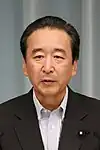
(cropped).jpg.webp)
